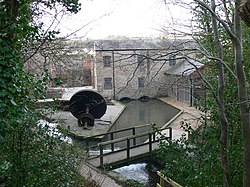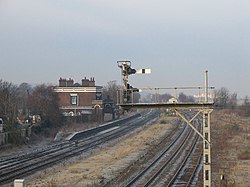Greenfield, Flintshire
| Greenfield Welsh: Maes-glas | |
| Flintshire | |
|---|---|
 Old cotton mill, Greenfield | |
| Location | |
| Grid reference: | SJ185755 |
| Location: | 53°17’20"N, 3°12’36"W |
| Data | |
| Population: | 2,741 (2011) |
| Post town: | Holywell |
| Postcode: | CH8 |
| Dialling code: | 01352 |
| Local Government | |
| Council: | Flintshire |
| Parliamentary constituency: |
Delyn |
Greenfield is a village in the parish of Holywell, Flintshire, on the edge of the River Dee estuary. At the time of the 2001 census it had a population of 2,741,[1] which remained unchanged in the 2011 census.[2]
The Welsh language name of the village, Maes-glas or Maesglas, has the same meaning as "Greenfield".[3] The name Maesglas was recorded in 1579,[4] with the English version recorded as "Fulbroke al[ias] Greneffelde" as early as 1540.[3]
History
Greenfield is best known for its history of papermaking. A paper mill has been on this site since 1770. The site was chosen due to the constant water flow from the stream which comes from the St Winefride's Well. The speed this site developed was one of the reasons that Greenfield is still linked with the start of the Industrial Revolution. In the mid 19th century up to 80 businesses had set up in the mile stretch between Holywell and Greenfield The remains of some can now be seen as conservation and industrial archeological projects have been undertaken in recent years. Among the businesses were a copper mill, a flannel mill, a flour mill, shirt-makers and soft drink works, W Hall & Son (which still exists today). Greenfield was also home to two Courtaulds rayon factories and a sulphuric acid plant from 1936 to 1985.[5]
In 1842 William Crockford, of London gambling club fame, built the Zinc Smelting Works on the northern side of the coast road adjacent to the gas works. The factory was said at the time to be the most modern in Britain with its own dedicated railway to the nearby Crockford Wharf. Crockford died in 1844 and his widow Sarah continued running the factory with the assistance of a daughter and two sons - Fanny, Henry and Charles Crockford, the latter of whom patented several zinc smelting inventions. The family also laid a mineral railway from Pantasaph to the factory, converted Parys Mine works into a limestone crushing plant and ran a cement factory at Bryn Celyn. With industrial changes and periodic managerial problems output from the zinc works ceased by the turn of the century and derelict buildings were largely removed by 1928.
Greenfield's oldest building is Basingwerk Abbey, founded circa 1132 by Ranulph de Gernon, 2nd Earl of Chester. It was an important monastic centre in north Wales; both Llywelyn ap Iorwerth and Dafydd ap Llywelyn were patrons. In 1536, abbey life came to an end with the Dissolution of the Monasteries. In ruins since the time of Oliver Cromwell, it is in the care of Cadw. The ruins are now part of Greenfield Valley Heritage Park, with the adjacent grounds home to an agricultural museum.[6] Many of the museum's buildings were moved stone by stone from the surrounding area, including an old school house.
Holywell Junction Railway Station
The North Wales Coast Line runs through Holywell Junction with trains running fast through the station.

The station was opened on 1 May 1848 as part of the Chester and Holyhead Railway and was named simply Holywell.[7] A brick-built signal box was opened in 1902 to replace an earlier wooden one. The station initially had two platforms but as the line grew busier the number of tracks doubled from one each way to two and the number of platforms followed suit. The main station building was positioned on the down platform and a subway connected them all. In 1912 Holywell Branch Line was opened just east of the station which linked the mainline to the centre of Holywell.[8] Therefore, Holywell station was renamed Holywell Junction on 1 May and the new station called Holywell Town.
The branch line lasted 42 years before being closed and Holywell Junction was closed to passengers on 14 February 1966[7] as part of the Beeching Axe, although it was open to freight until 1970. The Italianate station building designed by Francis Thompson[9] was listed Grade II* in 1970[10] and is a private dwelling. The signal box was listed Grade II in 1991.[11]
Description
The B5121 road from Greenfield to Holywell is the road which passes the St Winefride's Well, which Holywell is known for.
The old village primary school, which was just under 100 years old, was controversially demolished in 2005, after much opposition from local residents. A covenant in the deeds of the land on which the old school was built, stated how the land was sold by the Mostyn Family on the condition it was only to be used solely for educational purposes. Although this point was expressed to Flintshire County Council, they proceeded with the demolition. A new school was built to replace it, but in a different part of Greenfield. Both schools were named Ysgol Maesglas (Greenfield School).
References
- ↑ UK Census (2001). "Local Area Report – Greenfield Ward (00NJQK)". Nomis. Office for National Statistics. https://www.nomisweb.co.uk/sources/census_2001_ks/report?compare=00NJQK}}
- ↑ UK Census (2011). "Local Area Report – Greenfield Ward (W05000204)". Nomis. Office for National Statistics. https://www.nomisweb.co.uk/sources/census_2011_ks/report?compare=W05000204. Retrieved 27 January 2021
- ↑ 3.0 3.1 Davies, E. Flintshire place-names, 1959, p.77
- ↑ Davies, 1959, p.104
- ↑ "House of Commons debate: Courtaulds (Greenfield Plant)". Hansard. UK Parliament. 17 June 1985. http://hansard.millbanksystems.com/commons/1985/jun/17/courtaulds-greenfield-plant.
- ↑ "Map & visitor information". Greenfield Valley Heritage Park. http://www.greenfieldvalley.com/pages/heritagepark.htm.
- ↑ 7.0 7.1 "Holywell Junction". Disused Stations. http://www.disused-stations.org.uk/h/holywell_junction/.
- ↑ "Holywell Town". Rhyl & District Model Railway Club. http://www.penmorfa.com/rdmrc/holywell%20town.html.
- ↑ "Transport Heritage website". National Transport Trust. http://www.transportheritage.com/find-heritage-locations.html?sobi2Task=sobi2Details&sobi2Id=117.
- ↑ "Holywell Junction railway station". http://www.britishlistedbuildings.co.uk/wa-510-holywell-junction-railway-station-holywell/osmap.
- ↑ "Holywell Junction signal box". http://www.britishlistedbuildings.co.uk/wa-511-signal-box-at-holywell-junction-railway-sta.
Outside links
| ("Wikimedia Commons" has material about Greenfield, Flintshire) |
